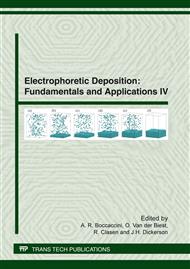p.181
p.191
p.197
p.203
p.209
p.215
p.221
p.227
p.233
Characterization of a Ceramic Powder Surface by Contact Angle Measurements and Infrared Spectroscopy
Abstract:
The surface chemistry of a suspended particle greatly affects it behavior during electrophoretic deposition. The type and amount of surface groups determines whether the particles can be charged by interaction with the solvent. Furthermore, it is suspected that the surface chemistry plays a prominent role in the mechanisms governing the actual deposition of the particles. In the present work the surface chemistry of as-received and surface modified alumina powder is characterized by means of contact angle measurements and Diffuse Reflectance Infrared Fourier Transform spectroscopy. The wetting is measured using a modified Washburn method which yields quantitative contact angle values. The acid-base and dispersive surface energy components are calculated from these values using the surface tension component theory. Infrared spectroscopy was used to compare the surface groups of the treated and untreated powders and confirm the trends in surface properties as calculated from the contact angles.
Info:
Periodical:
Pages:
233-238
Citation:
Online since:
March 2012
Price:
Сopyright:
© 2012 Trans Tech Publications Ltd. All Rights Reserved
Share:
Citation:


